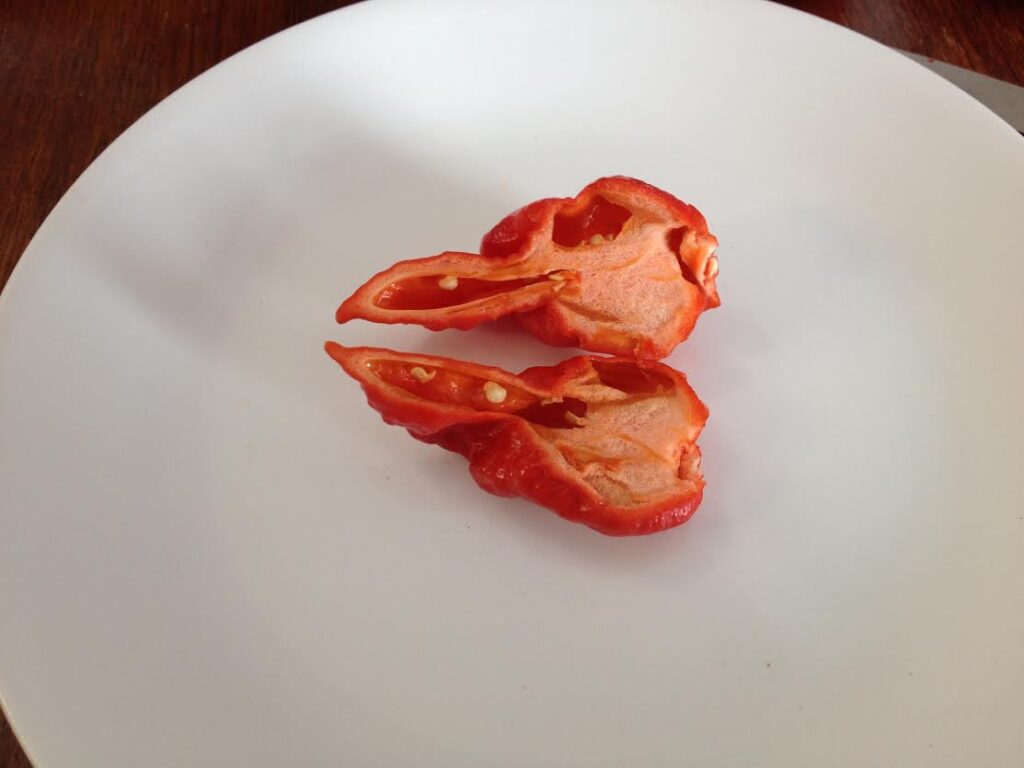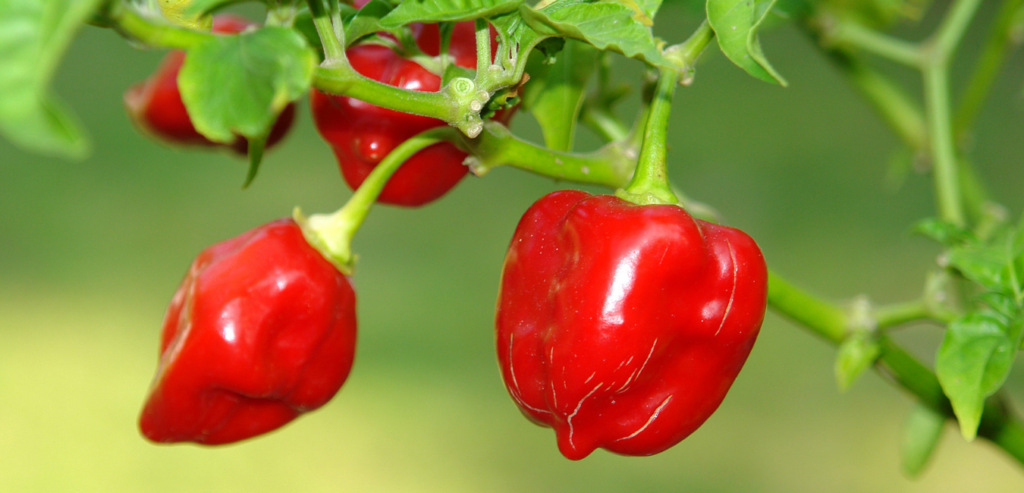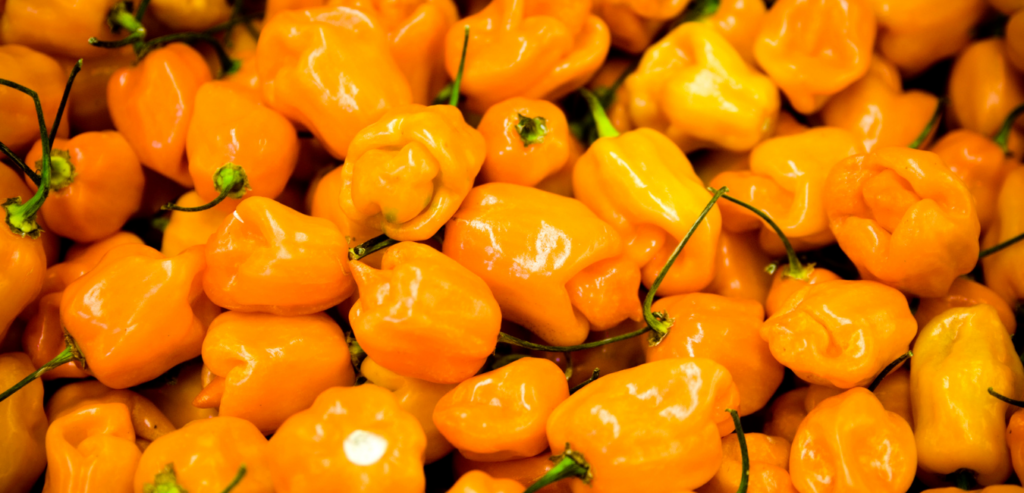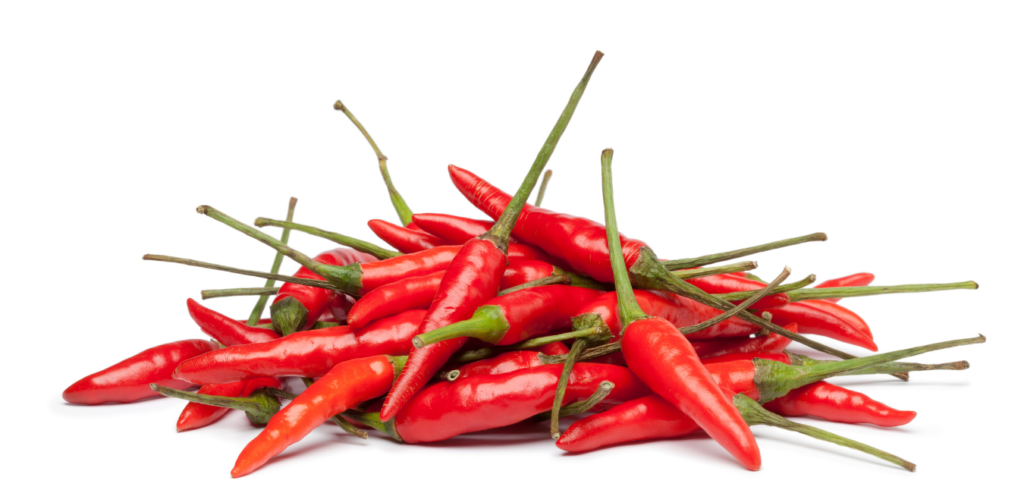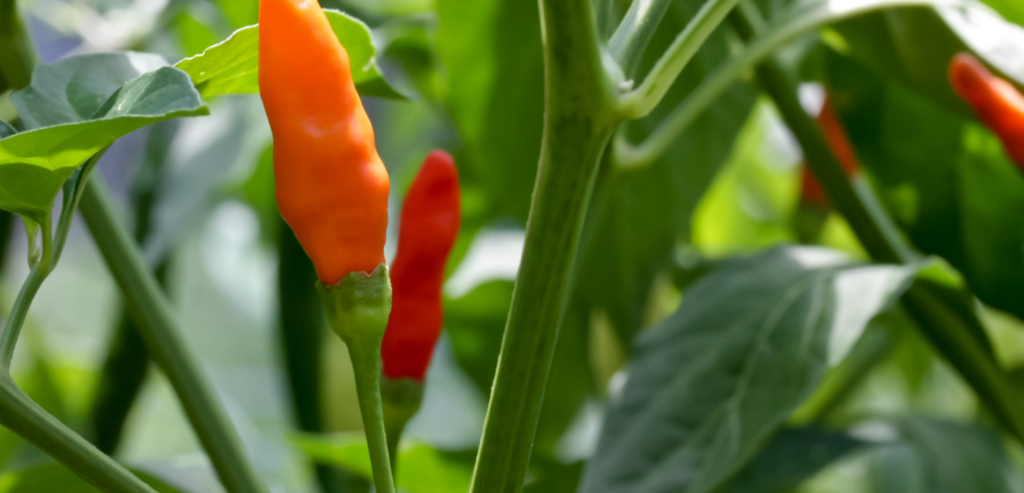For lovers of TheSauceMan products, you’ll be able to find some interesting articles, curiosities and intriguing facts about chutneys, hot sauces and chilies.
Carolina Reaper – The World’s Hottest Chile
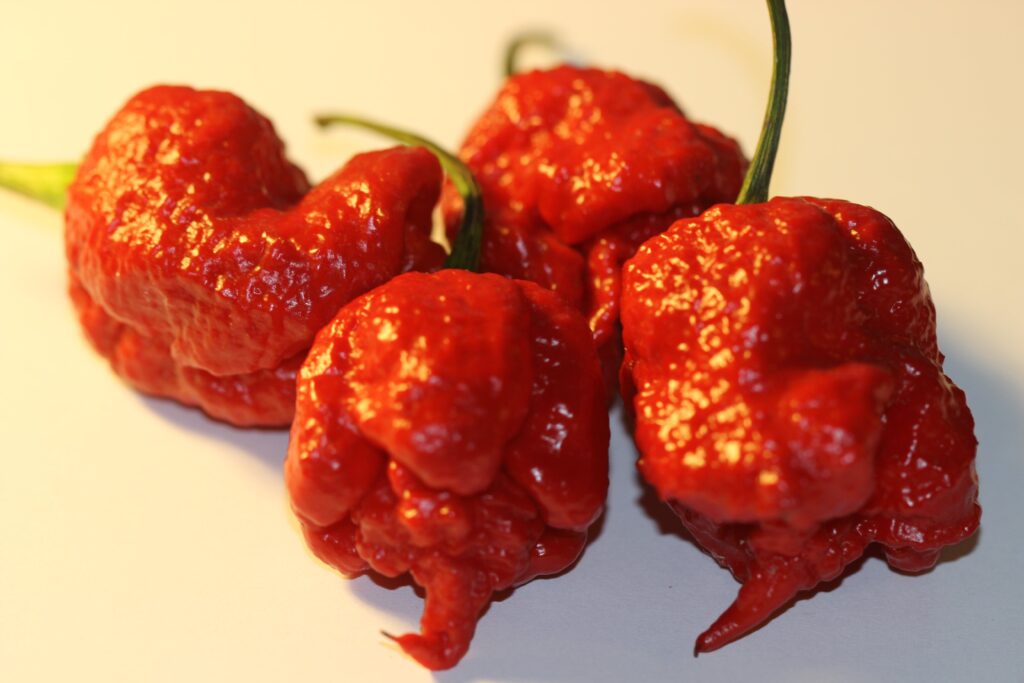
Guinness World Records declared this the hottest Chile pepper in the world in 2017, racking up a brain-haemorrhage inducing 2.2 million on the Scoville scale. Bearing in mind the searing Habanero has a Scoville rating of around 200k, these absolute shits are about ten times hotter. This means that they won’t just blow your head off but probably of your intestinal tract and possibly the alveoli on your lungs too. Just to give some context the pepper spray used by law enforcement agencies throughout the world is at a similar level to this frightening fruit.
I can personally attest to its intensity as I tried a tiny piece of one in a taco and I have no shame in relating that it was quite a traumatic experience. My stomach felt like it had a dancing shrew in it, and my lungs felt like I had tried to smoke the sun. I spent the rest of the day mainlining yoghurt, bread and limes to try and regulate my body’s temperature.
They are interspecific hybrid chiles, which in plain English means that are genetically modified to annihilate your mouth, tongue and taste buds (along with your will to live for several days.) They were bred by Ed ‘Smokin’ Currie in his greenhouse in South Carolina, a place known for its friendly neighbours, great peaches and psychotic chilli farmers who want to eradicate the human race via the medium of tacos. It is a member of the nightshade family and is a genetic mix of the Soufriere pepper from the Caribbean island of St. Vincent and a Naga Viper pepper from highlands of Pakistan. It acquired the moniker ‘Reaper’ due to its pointed tail (The Carolina bit is fairly self-explanatory). Any affiliation with the grim reaper is, I am assured, purely coincidental.
They are small and red with a wrinkly, gnarly, thick skin and an extremely high capsaicin count giving them their legendary spice level. I found some tasting notes online which stated that they had a gently fruity taste, sweet on the first bite, before turning into molten lava on your tongue.
These botanical bastards are fairly easy to cultivate and like a temperate of between 18 and 20 °C (64–68 °F) and grow best in pots of around 15-20cm with moderate sunlight exposure.
Carolina Reaper chile peppers are an excellent source of vitamin C, which is an antioxidant that can help protect the immune system (assuming that you don’t die while consuming them). The high content of Capsaicin has been shown to have anti-inflammatory properties and causes the body to release endorphins to counteract the perceived pain, known as a ‘chile high’. I mean, there has to be some upside.
In terms of gastronomical uses they are great to flavour chicken, steak and noodles. Use EXTREMELY sparing unless you have a very good lawyer and are comfortable with being charged with an accessory to homicide. YOU HAVE BEEN WARNED.
Sriracha Sauce – Brings the Asian Heat
Contrary to what you might think, Sriracha isn’t a brand of sauce, it’s a style of sauce. There is much debate around the origins of Sriracha, but we can confidently trace the original recipe back to 1949 and a woman called Thanom Chakkapak resident of Si Racha, Thailand. Chakkapak knocked up a batch of her sauce and added it to everything she cooked in her small, neighbourhood restaurant. Word soon spread around her vicinity and everyone was rocking up just to get a taste of the spicy elixir. Thanom then started selling the product down her local market to great fanfare and admiration.
The ingredient list includes chillies (I suspect red bird’s eye or red jalapeños given the taste and its region of provenance), spirit vinegar, sugar and salt. Given the taste there’s some ginger and garlic going on there and, in the Thai version at least, there’s also an unmistakable hint of Kaffir limes. Overall it’s a pretty good bet and has a great balance of sweet, salty and hot. For heat heads, the 1k – 2.5k Scoville scale ensures that it will satisfy your picant cravings.
The sauce was brought into the USA by David Tran, a Vietnamese immigrant living in the USA, who started Huy Fong Foods USA (which translates to ‘gathering prosperity’) and he started producing the sauce in his factory in San Francisco. The famous brand is known as ‘Rooster’ or ‘Cock’ sauce (no sniggering in the back) due to the magisterial looking cockerel depicted on the bottle. The sauce has now become ubiquitous and sells around 20 million bottles per year. Brands as famous as MacDonald’s and KFC have produced their own version. The Huy Fong Food brand also makes a Sriracha Mayo which is great for giving a pleasant zing to sandwiches and burgers without excessive heat.
The original Sriracha is especially great with Thai or Chinese food, as being perfect for dipping fries, nachos and chicken. One of my favourite recipes is Sriracha special fried rice. Use leftover rice (it must be cold!) for this wonderful dish. Heat a wok (or frying pan) and add some oil (sunflower or peanut). Then add some chopped garlic and then some fresh prawns (shrimp). Ove they are cooked through, add some thinly sliced onions. Once they have softened add the rice and give it a toss to ensure all the grains are glossy, Make a well in the rice and crack in an egg and scramble it with the back of a spoon. Then whack is some soy sauce and some Sriracha. Add some chopped ham and some peas and you’re good to go.
Fun fact: In 2013 residents of the town where the factory is located complained of eye irritation, headaches, heartburn, sore throats, and other issues. They blamed it on chile emissions. Huy Fong stated that ‘they are probably the kind of people who don’t season their food, but who knows?’. Passive aggressive? Moi?
CHILLI HABANERO/ SCOTCH BONNETS – THE KING OF CHILI PEPPERS
In my humble opinion, the Habaneros are undoubtedly the king of chile peppers. They are a great all round chile; enticing appearance, great taste and a spicy but-not-too-powerful heat level.
The name Habanero comes from the Cuban capital which was a major trading point for these little hot bombs. Actually talking of hot bombs in the context of US-Cuba relations is quite apt. After diplomacy broke down the main Habanero hub moved to the Yucatan province in Mexico where they produce about 1,500 tonnes per year.
They are the botanical cousins of another of my favourite chillies, the Scotch Bonnet (from the Caribbean) where they are often used in jerk seasoning. If you don’t know about jerk, you’d better get to know about jerk; it’s a great combo if thyme, scotch bonnets, allspice and brown sugar all mixed up and then used as a rub for goat, ham or anything else you can smoke in an oil drum.
In terms of appearance they look like normal bell peppers, but in miniature format. Don’t make the mistake of thinking you can dip them in some hummus or guacamole and enjoy your dinner party because you won’t. You will end up spluttering, coughing and turning red like a vicar in a strip club. These diminutive devils are pretty punchy, racking up an impressive 200,000 on the Scoville scale which means they will give you a nice, tangy heat but they won’t eat away at your upper respiratory tract like a ravenous zombie.
They tend to be one of my go-to chillies. Sometimes I cut them up and use them in the sofrito (tip: wear gloves if you intend to touch your eyes or go to the bathroom within the next 30 days). On other occasions, I will whack them into a sauce whole and then squash them down with the back of a spoon to get the spicy goodness out of them and leave it to lady luck to see who is the lucky recipient of this lava-esque nugget. They are also great in fresh salsas; a generous splash of lime juice, some salt, some cilantro and some onion and tomato and you have a great accompaniment to any dish (I don’t mean literally any dish – it probably won’t be the best pairing with a rice pudding or a Chantilly cream, but you get my drift.)
If you want to experience a real full on flavour sensation, then get yourself on TheSauceMan’s sauces. The Original Habanero is made with these beauties in abundance, bringing out the sweet, zesty notes with a combination of spices and vegetables that will blow you away (and not because of the heat level).
Habaneros are usually red, orange or brown. The brown (or chocolate) Habanero is another of my favourites, a little spicier than the original with a slightly acidic edge. The darker they Habanero gets the stronger they are. I like to use them when they are in their orange form, they are a little less aggressive that the dark red version with a slightly more floral, grassy flavour.
These little babies flourish in sunny, dry conditions and are super easy to grow, and give an impressive yield. Perfect for home growing and most importantly delicious as hell (though a lot less hot).
TABASCO – THE WORLD’S BEST KNOWN HOT SAUCE
Tabasco is probably the world’s most recognisable hot sauce, available in over 195 countries and sells a staggering 700,000 bottles every day.
The company was founded in 1868 by Edmund McIlhenny. He started the company after his aspirations to become a 19th-Century Wolf of Wall Street went awry due to the enduring financial crisis. Unperturbed, Mr McIlhenny worked on his pepper sauce project in an attempt to add some life to the generally bland and monotonous Louisiana diet.
Unsurprisingly, the main hot pepper used in Tabasco is the Tabasco pepper. The Tabasco pepper originates from the Mexican state of Tabasco. The peppers are unusual as they are quite ‘juicy’ rather than being dry and have a slightly acidic, citric flavour and are somewhere in the middle of the road in terms of heat (around 30k on the Scoville scale). In terms of growing they are somewhat temperamental; they’re known as the Goldilocks of the chilli world: it can’t be too hot and it can’t be too cold. For many years the peppers were grown on-site on Avery Island, South Louisiana, where the Tabasco sauce factory is located. The majority of the peppers are now grown in South America due to favourable climate conditions, greater capacity to grow all year round and more space to cultivate. The peppers have always been picked by hand and still are. The pepper collectors have a small red stick which they compare to the growing chillies in order to maintain a uniformity of ripeness and a repeatable product.
Once picked, the peppers are then mashed and placed in whisky barrels where they are ‘aged’ for between three and eight years. This process is similar to the ‘aging’ process in whisky, wine and rum. Wooden barrels (usually oak) are ‘charred’ (burnt with a flamethrower) which unleashes a whole host of flavouring and filtering properties, giving the spirit or wine a deeper, more complex flavour. A similar process is used with the Tabasco mash. After the ‘aging’ process is complete, the mash is then mixed with vinegar and sugar and the liquid bottled in the signature cologne bottles. Tabasco has released a number of special editions such as Habanero, Chipotle, Jalapeno and Sweet and Sour.
Fun fact one: The left over peppers are sold to pharmaceutical companies which they use to produce pepper spray.
Apparently Queen Victoria was a huge fan and the bottle bears the Royal Crest. Legend has it that she ran out during the nadir of World War 2, she ran out and sent out one of her lackeys to scour the street of London. He came back empty handed. Apparently she took the bad news ‘philosophically’. Her disappointment meant that Tabasco wasn’t awarded the Royal Warrant until 2009.
It’s unusual that a company with such a long and esteemed history of hot sauce make a product that is so utterly dire. Astringent, vinegary, watery and super spicy, it has almost no redeeming features except for the cute label bearing the presidential seal.
Fun fact 2: the US, Australian, British and issue miniature bottles in their ration packs. I’m not sure how it would help moral. Unless you were trying to poison your enemies with it.
CHIPOTLE AND JALAPEÑO PEPPERS – ONE CHILE OR TWO?
Hang on, these are not the same thing; Jalapeños are the things in a jar that I put on my nachos and Chipotle is in my favourite hot sauce (hint: it’s TheSauceMan Beetroot and Chipotle), so what’s the scoop? Well they are, in fact, one in the same.
When they are green on the vine, they are a little bitter and sour. You will rarely see them in this form, you are more likely to see them pickled in cans or jars. They have a pleasantly sharp, acidic flavour and add great contrast and a little kick to a whole variety of dishes. You are probably most familiar with them on your nachos down the local Mexican bar, where they cut through the salty chips and cheese combo like a rapacious 14th century explorer’s machete through the wilds of virgin rainforest.
Next, we move onto the ubiquitous Chipotle. As I mentioned before, it is the same chilli as above but this time left on the vine to mature to a deep mahogany red. They are then harvested, and placed in wood fire smokers, where they are smoked to within an inch of their life over several days taking the moisture content down from 88% to 8%. When they emerge from their smouldering chrysalis they are shrivelled up like a raisin after a gap year in the Gobi desert and have a wonderful smoky, woody aroma. There are actually two main varieties; the Morita and the Meco. The former is smoked for less time and has a deep purple colour. The latter has a rather unappetizing bark-like appearance (almost like the shell of a cigar) but is more prized than the Morita due to its deep intense, earthy flavour. They are then milled to a powder (think spicy paprika) and used for marinades, soups and sauces.
If you are fortunate enough to get a glimpse of one before smoking, you will see the characteristic brown ‘scorched’ lines. Fun fact: the more brown lines there are the hotter the chilli. No fear though, these are definitely at the mellower end of the Scoville scale, sitting somewhere between 4,000 and 8,000, giving a very gentle warming heat and are a great for giving a very gentle kick to your dishes. At The SauceMan we use the superior Meco chillies, offsetting the sweetness of the beetroot and orange juice, and complimenting the sizzling Habaneros and fragrant hit of rosemary to perfection.
This chilli is predominantly grown in the south of the USA and Mexico and is somewhat of a delicate flower – they need to be kept warm at night, are very susceptible to plagues and aphids and need to be well watered but not overwatered. You’re probably better of getting your Chipotle fix from your favourite hot sauce brand. I think I mentioned it at the beginning of the article.
THE BIRD´S EYE CHILI – SMALL YET POWERFUL
The Bird’s eye chile or Capsicum annuum is one of the most commonly found chiles in the world. The name remains somewhat of a mystery, as the appearance of the chile is similar to a birds beak, not a birds eye (unless the bird in question was reared in Chernobyl).
They are a perennial fruit (meaning they grown all year round), measuring around 4-6cm in length and are most commonly used when green or red. They have a fruity, peppery taste and pack a pretty powerful punch, measuring between 50k-100k on the Scoville scale, with the African version considerably hotter, reaching up to 175k. When they are green on the vine they tend to be a little more sour and bitter, great for providing a contrast in your dishes, while the red version is hotter with more pronounced fruity overtones. These chilies are popular all over the world, but are particularly common in South East Asia, and are a staple ingredient of many Indian, Vietnamese, Indonesian and Malaysian dishes. They are also omnipresent in many parts of Southern Africa and form the base of the famous Peri Peri dishes.
As with all chiles their origins lie in Central and South America (principally Mexico) and were then spread all over the globe by Spanish and Portuguese explorers. The Portuguese were obviously the better salesmen and they spread their botanical seed far and wide throughout their (then) colonies, most noticeably Africa (hello Peri Peri) and the South of India (hello Vindaloo). The Portuguese cottoned on to the value of chilies due to their similarity to black pepper (a highly valued commodity at the time), and they ease at which they grow in tropical Africa and South East Asia which provided the ideal growing conditions of fertile land, high humidity and clement temperatures. The Portuguese certainly left their mark and the unstoppable march of these piquant peppers began from the early 15th century.
If you’re already a vociferous bird’s eye chile consumer, then you can rest assured you’re enjoying a whole host of benefits that chile peppers can provide such as regulating your metabolism, banishing migraines, clearing a blocked nose and reducing joint inflammation.
If you’re not yet a convert of this little devil then here’s a simple and delicious recipe for Peri Peri Chicken, similar to one you might get delivered from Nandos. Let’s call it a fakeway. Take eight chicken thighs (drumsticks will work too) and score them with a knife. In a bowl blend two or three chopped Bird Eye Chiles, a couple of cloves of chopped garlic, two teaspoons of smoked paprika, two teaspoons of oregano, some salt and pepper to taste and the juice of two limes. Mix the concoction together, and lather over the chicken, making sure to get all the way into those nooks and crannies. Cover the chicken and leave to marinade in the fridge for up to 24hrs. Preheat your oven to 180 ° and put in the chicken for 40 minutes. Serve with coconut rice and a slaw.
Fun fact – the African Bird’s Eye chili grows with the fruit pointing upwards, while its Asian brother’s fruit grows pointing down.



